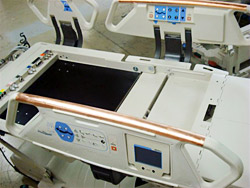Antimicrobial Properties of Copper
Historic Uses of Antimicrobial Copper
 Typical brass mutka from rural Rajasthan, India
Typical brass mutka from rural Rajasthan, India Today, Hospital Infection Control is a Key Issue
The Centers for Disease Control and Prevention (CDC) estimate that more than 2 million patients contract a hospital acquired infection each year in the USA, resulting in nearly 90,000 deaths. In March of 2009, the CDC estimated direct hospital medical costs to be $35-45 billion.
Common hospital materials – stainless steel and plastics – are colonized by microbes that can persist for days or weeks thereby becoming a source of contamination to hands and equipment of healthcare workers, professionals, visitors and the patients themselves.
 ICU room
ICU room The CDC's recommended practices of washing hands before and after seeing patients is sound and necessary, along with the wiping and disinfecting of all touch surfaces. However, the intrinsic antimicrobial properties of copper and copper alloys (brasses and bronzes) for hospital hardware and equipment add another layer of continuous protection against a wide range of pathogens and multi-drug resistant bacteria such as Methicillin-resistant staphylococcus Aureus (MRSA), Eschericia coli 0157:H7, Pseudomonas aeroginosa, and Enterobacter aurogenes, thereby complementing the practical CDC guidelines and practices.
 Copper rails
Copper railsA multi-year study funded by the Telemedicine and Advanced Technology Research Center, US Army Medical Research and Materiel Command is showing the beneficial effect of copper surfaces in the reduction of microbial burdens, as compared to non-copper surfaces. This study involves the evaluation of three specific bacterial pathogens: Methicillin-Resistant Staphylococcus aureus (MRSA); vancomycin-resistant Enterococci (VRE), and Staphylococcus aureus, along with total gram negatives and total bacteria; and three different medical facilities focused on three distinct patient populations. The hospital centers are Medical University of South Carolina (MUSC), Memorial Sloan-Kettering Center, and Charleston Research Institute at the Ralph H. Johnson VA Medical Center. This study:
- Introduced copper touch surfaces and measured their positive effect at reducing the levels of harmful microbes;
- Is measuring how the bioload reduction in the hospital environment may improve clinical outcomes; and
- Demonstrated that the inherent antimicrobial effects of copper and its alloys can augment recommended CDC practices.
Resources:
Telemedicine and Advanced Technology Research Center, US Army Medical Research and Materiel Command, 2009 Annual Report, pps 126-127. Complete report is available on TATRC site.